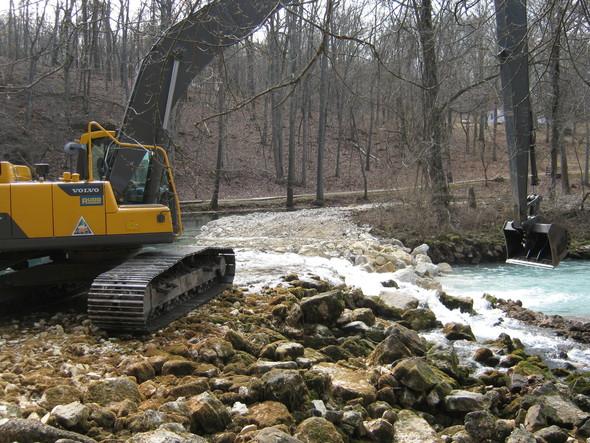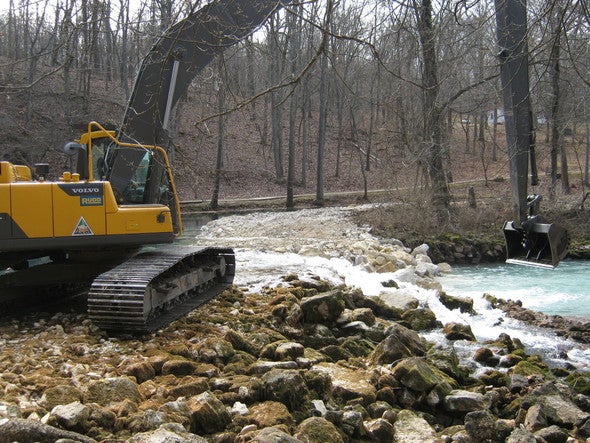
Xplor reconnects kids to nature and helps them find adventure in their own backyard. Free to residents of Missouri.


































Stay in Touch with MDC news, newsletters, events, and manage your subscription

Xplor reconnects kids to nature and helps them find adventure in their own backyard. Free to residents of Missouri.

A monthly publication about conservation in Missouri. Started in 1938, the printed magazine is free to residents of Missouri.






St. JAMES, Mo.— The Maramec Spring Trout Park near St. James could have lost thousands of fish were it not for the actions and innovation of Missouri Department of Conservation (MDC) staff.
Last December’s flood not only wreaked havoc in the St. Louis area, but it created a crisis at the trout park as well. The park contains the fifth largest spring in the state with an average water flow of 100 million gallons per day. Three days of non-stop rain soaked the St. James area just after Christmas with 9 inches of moisture. This caused flood waters to swell.
“Floods are something the crews at Maramec Spring and all trout hatcheries are fairly accustomed to,” said Wesley Swee, MDC trout hatchery manager.
Hatchery staff responded by putting aluminum screens over the trout pools, which is standard flood protocol. The screens keep the fish in their respective pools as the flood waters rise above the walls of the pool. This particular rain event, however, packed a bigger punch. Much of the rain was concentrated over the park’s namesake spring that supplies the hatchery with the cool water trout need for survival. After hours of unrelenting downpour, the spring’s flow began to increase.
“The boil of the spring was pumping out massive amounts of water. It was violently blowing out of the cave, unlike anything we had seen before,” reported Swee.
While there was no official measurement, Swee estimates the spring’s flow during the breach was close to the recorded high of 400 million gallons per day. Suddenly alarms sounded at pool five, indicating a significant loss of water levels. When hatchery staff went to investigate, they observed water rapidly dropping in pool five. Swee discovered the cause on reaching the dam that holds water in the pool; a breach was starting to form with the raging water continuing to cut into the dam.
Hatchery personnel were concerned the spring pool would eventually drop below the rearing pools, cutting off water flow to the trout. In the next few weeks, the spring’s flow slowly decreased and within a month the spring pool had fallen more than two feet. Fears were confirmed that the pool could ultimately be left dry and cause a catastrophic loss of fish.
To prevent this, hatchery staff employed 200hp diesel water pumps to keep the pool flowing. These provided the fish with the necessary water to keep them alive. But at a cost of a gallon of diesel per hour, it was not a sustainable solution. According to Swee, the fish would perish within 30 minutes should the pumps fail.
After meetings with MDC staff and The James Foundation, owners of the trout park, a plan was devised to repair the dam.
“Fixing the dam was actually going to be the easy part, the difficult part would be getting equipment to the site to make the repairs,” Swee pointed out.
MDC crews needed a way to move dump trucks, bulldozers and track hoes to the dam safely for the repair. The dam was originally built in the early 1800s and the road to it was too narrow to transport heavy equipment. A new access road had to be created. The plan called for building a road from the museum parking lot over the mill race arm, along the levy and ending at the dam. MDC staff was determined to complete the repair before the March 1 trout season opener.
MDC construction crews broke ground the week before opening day. To cross the water portion of the mill race, crews placed four culvert pipes measuring three feet in diameter and 30 feet long in the channel, covering them with rock to build a water crossing. They placed additional rock along the levy to widen the road.
Using the new access road, crews brought large boulders to the edge of the breach to fill the rock dam’s 12-foot deep scour hole, and pushed them into place with a dozer. As the scour hole filled up, some of the larger boulders were used to choke off the flow going through the breach. The spring pool began to rise after a few boulders about the size of a riding lawn mower were carefully bedded down. It only took a couple more loads of rock carefully placed in the breach before the pool was back up to full pool and going over the entire length of the dam.
After five days of construction, the dam was repaired and crews were able to shut the diesel pumps down.
“Hopefully after a few months of grass and algae growth, you won’t even notice they were there,” said Swee.
More than a thousand anglers visited the park March 1 and enjoyed a successful trout season opener.
“Thanks to the support of the MDC Design & Development Division, the James Foundation, and a very dedicated hatchery staff, Maramec Spring hatchery didn’t lose a single fish in the dam breach of 2015,” Swee said.
The Maramec Spring Hatchery is operated by MDC. Maramec Spring Park, which is owned and operated by The James Foundation, and can be reached by taking the I-44 “MO-8” exit at St. James, then travelling about six miles east on Highway 8. The park hosts more than 50,000 trout anglers each year.
Conservation makes Missouri a great place to fish. For more on trout fishing, go online to https://huntfish.mdc.mo.gov/fishing/where-fish/trout-areas.